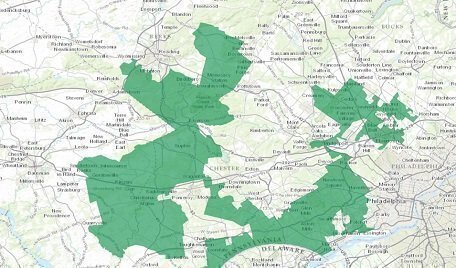The Pennsylvania Supreme Court’s ruling striking down a state legislature’s district-defining map for this year’s congressional elections in the state cleared a potential legal hurdle Monday when Supreme Court Justice Samuel A. Alito, Jr., refused to block that decision.
 Alito gave no reason for rejecting a postponement request by state GOP legislative leaders but his denial was a fairly strong hint that the Supreme Court is not likely to review the ruling by the state’s highest court, probably out of respect for that tribunal’s authority to apply its own state constitution’s protection for voters’ rights. This marked the first time that the Supreme Court or any Justice had taken action to allow a lower-court ruling against “partisan gerrymandering” to go forward.
Alito gave no reason for rejecting a postponement request by state GOP legislative leaders but his denial was a fairly strong hint that the Supreme Court is not likely to review the ruling by the state’s highest court, probably out of respect for that tribunal’s authority to apply its own state constitution’s protection for voters’ rights. This marked the first time that the Supreme Court or any Justice had taken action to allow a lower-court ruling against “partisan gerrymandering” to go forward.
The practical effect of Alito’s action appears to be that the state legislature in Harrisburg will have to go forward under the state court mandate to draw new congressional district lines that do not favor Republican candidates at the expense of Democratic candidates.
Under the maps invalidated by the state court last month, Republicans have won 13 out of the 18 seats in the U.S. House of Representatives, Democrats winning only in the other five – even though the statewide voting for such candidates has been split about evenly. The partisan shape of the state’s House delegation had been the same as a result of three elections since 2011.
Experts on redistricting in the state have predicted that, if “partisan gerrymandering” were not allowed, Democrats might be able to gain as many as five more seats in the House delegation. Nationally, if that were to happen, it could enhance the Democrats’ chance of gaining enough seats to take control of the House in Washington.
Under the Supreme Court’s normal procedures, a request to delay a lower court ruling pending an appeal to the Justices goes to a single Justice handling emergency requests from the geographic region involved. Pennsylvania is in the federal Third Circuit, and Justice Alito handles emergency pleas from that area.
Alito, under the rules, had the option of acting on his own, or referring the state GOP lawmakers’ plea to the full Court, but he chose not to do so. That, too, was a sign that the GOP challenge had dim prospects of succeeding.
Technically, the state Republican lawmakers have the option of asking another Justices for a delay of the state court ruling, but such “Justice-shopping” – as lawyers call it – seldom succeeds.
One of the key questions that a Justice or the full Court must consider in deciding whether to delay a lower court ruling is whether there is a reasonably good chance that, when a formal appeal arrives, it will be granted review. Thus, a denial is not a promising sign for those seeking to challenge the lower court.
Under the state Supreme Court ruling, the Pennsylvania legislature must produce a new map for the 18 House districts, without a partisan tilt, and do so by this Friday. It is to go to the state’s governor that day, for approval or veto. The governor is to act by February 15.
If the state legislature does not meet the deadline, or if it does but the governor disapproves what it has done, the state Supreme Court will move ahead on its own to draw new districting lines.
Those would first be used in a congressional primary – now set for May 15, although that date might be moved forward in the year. A special congressional election now set for March 13 to fill a vacancy in the 18th district will go ahead under the old map, the state court ruled.
The state Supreme Court did not spell out in its ruling just how the House map, drawn by the legislature in 2011, violated the state constitution, but the challengers had relied on four provisions of that document that protect equality and fairness in elections.
Although the Republican leaders of the legislature strongly opposed the state court’s decision, and asked Justice Alito to put it on hold pending a formal appeal, the legislature in the meantime has been going ahead with the attempt to draft new election boundaries that would satisfy the state constitution.







